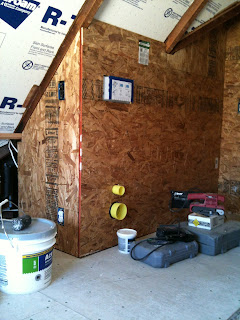I almost feel guilty. Almost.
We cleaned, scraped, stripped, washed, and dusted this floor to get it down to the bare wood. It's 19th-century virgin redwood, tongue-and-groove, about 3/4 of an inch thick. There aren't even any knotholes in it; it's all top-quality stuff. And we're about to bury it.
Partly that's punishment for all the $#@&! splinters this floor has given me. But mostly it's because we want to tile the floor. This one time we're not sanding and sealing the redwood like we did downstairs. A wood floor in a bathroom just seems out of place, and there would be no way to waterproof it. (There are sizable gaps between some of the boards.) Finally, this floor was tiled before, so there's old adhesive smeared all over it anyway. We're not doing anything that wasn't done before. The floor's just too far gone to try to leave it in its natural state. I'm sure the next homeowners will forgive us.
 So the next step in our tiling process is to put down cement backer board. This will give the tile a smooth, flat surface to adhere to. It also evens out dips and marginally waterproofs the floor in case of a bad spill. Hardie Backer is amazing stuff. It's basically a cement sidewalk sawed into thin 1/4-inch panels that you then glue-and-screw to the floor. As weird as it sounds, the stuff is actually very easy to work with. Unlike drywall, you can snap off pieces in a straight line, so you don't have to do a lot of messy sawing to fit around corners. (This is important, because you really don't want to inhale the dust this stuff makes. It's extremely abrasive -- it's cement, after all -- so use a mask and eye protection.)
So the next step in our tiling process is to put down cement backer board. This will give the tile a smooth, flat surface to adhere to. It also evens out dips and marginally waterproofs the floor in case of a bad spill. Hardie Backer is amazing stuff. It's basically a cement sidewalk sawed into thin 1/4-inch panels that you then glue-and-screw to the floor. As weird as it sounds, the stuff is actually very easy to work with. Unlike drywall, you can snap off pieces in a straight line, so you don't have to do a lot of messy sawing to fit around corners. (This is important, because you really don't want to inhale the dust this stuff makes. It's extremely abrasive -- it's cement, after all -- so use a mask and eye protection.) I got all the Hardie Backer down in a few hours, and with only a couple of irregular cuts. Naturally, it was the hottest day of the year so far, but Kathy was standing by with beer, so it all came out okay.

No comments:
Post a Comment